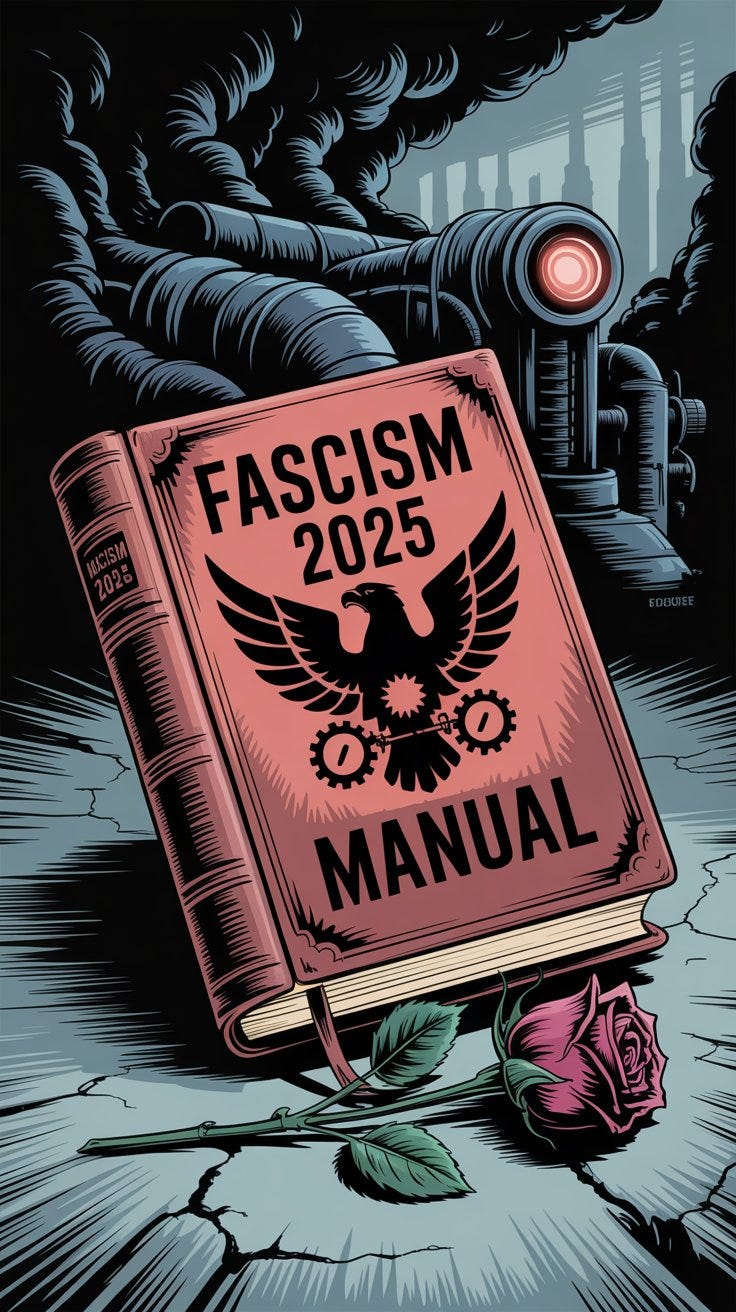When Evil Gets a Design System: Why “Fascism 2025” Is the Manual We Need
Or: What happens when hate learns to optimise for engagement
There’s a document circulating that refuses to behave like an essay. It won’t sit still. It won’t let you file it under “political commentary” and move on with your day. It’s called Fascism 2025: The Rebrand of Evil, and it does something most political writing has forgotten how to do: it names the machinery while the gears are still turning.
The author—writing under the name Lintara—calls it “a crib sheet, a splinter, a manual for tearing language back from those who polish it for murder.” That’s not marketing copy. That’s an accurate description of what you’re about to read. This isn’t analysis for the sake of understanding. It’s an analysis for the sake of survival.
And if you think that sounds dramatic, you haven’t been paying attention.
The Thing Everyone Feels But Can’t Name
Here’s what the essay gets right immediately: fascism didn’t die in 1945. It went into beta testing.
For decades, we’ve been waiting for the reappearance of jackboots and armbands, the unmistakable aesthetics of the last iteration. We were looking for Nuremberg rallies and book burnings. We got recommendation algorithms and content moderation policies instead.
Lintara writes: “The symbols got a UX team. The hate stayed. The kerning improved.”
That line does more work than most political theory books. It names the exact problem: we’re still scanning for 1930s fascism whilst 2025 fascism is optimising its landing page. It doesn’t march anymore. It syncs. It doesn’t demand your loyalty—it tracks your engagement metrics and adjusts the feed accordingly.
The new concentration isn’t camps. It’s metrics. People don’t disappear behind walls; they disappear behind algorithmic suppression, shadow bans, and “content that doesn’t meet our community guidelines.” The violence is still there. It’s just been rebranded as “optimisation.”
This is the infrastructure of evil in the age of platforms, and most of us have been too polite to call it by its name.
Language as Arsenic: The Slow Poison of Euphemism
One of the essay’s most vital contributions is its dissection of how language itself becomes weaponised—not through grand pronouncements, but through the quiet substitution of terms.
Victor Klemperer, quoted in the piece, observed that “words can be like tiny doses of arsenic; they are swallowed unnoticed.” Lintara updates this for the present: fascism no longer says “purify.” It says “simplify.” It doesn’t say “cleanse.” It says “curate.” It doesn’t say “forbid.” It says “streamline.”
Look at any recent policy document, any corporate diversity statement, any government announcement about border security or public safety, and you’ll see it: the violence of design is politeness with good kerning. Each “policy improvement” is a euphemism with a halo. The tone is calm. The sentence is irreversible.
This matters because we’ve been trained to respond to tone, not substance. A policy that “streamlines the asylum process” sounds reasonable. Efficient, even. Until you realise “streamline” means “eliminate due process” and “process” means “people.” The smooth language makes the violence invisible. That’s not an accident. That’s the design.
Lintara writes: “If the term slides when you press it, press harder. Fix it to the body. Count who pays.”
This is the instruction manual: when you hear a euphemism, translate it immediately into its material consequence. Who loses their home? Who loses their child? Who loses their life? The moment you fix the language to the body, the spell breaks.
The Hook: How Radicalisation Became an Assembly Line
The section titled “The Hook” should be required reading for anyone trying to understand how ordinary people become foot soldiers for fascism. It’s not about inherent evil. It’s about engineering.
Here’s the progression Lintara maps:
You’re not worse. (Relief)
You’re better. (Pride)
You have the right to judge. (Permission)
Hierarchy is natural. (Structure)
Violence is necessary. (Action)
Each step is small. Each step feels justified. And by the time you reach the end, you’re holding a list of names and you believe it’s your duty.
The formula is even cleaner: not equal → superior → sovereign → executioner.
This isn’t radicalisation as psychological collapse. This is radicalisation as product funnel. There are people whose job it is to move you from step one to step five. They A/B test the language. They optimise for conversion. They know exactly which grievance to activate, which fear to amplify, which enemy to name.
The bait is grievance. The line is tradition. The reel is purity. The boat is the nation.
And here’s the thing that should terrify you: it works. It works on the lonely teenager scrolling through YouTube at 2 am. It works on the redundant factory worker who’s been told the problem is immigration, not automation. It works on the suburban parent who’s been convinced that their child’s school is indoctrinating them.
Fascism doesn’t summon hate. It grooms despair. It identifies the wound and then it infects it. By the time the hunt begins, the scapegoat already believes he’s the shepherd.
The instruction here is simple: Name the hook. When you hear “you’re not worse,” ask immediately: at whose expense is my better? Break the mechanism before it breaks the mouth.
Silence Isn’t Neutral—It’s Logistics
This is where the essay becomes uncomfortably personal. Because it’s not just about the fascists. It’s about the rest of us. The reasonable ones. The quiet ones. The ones who think neutrality is a virtue.
Lintara writes: “Silence is not peace; it’s inventory. It clears the street for the van.”
That image—the street cleared for the van—is from the section titled “Visitation,” and it’s the one that should follow you home. Black headlights at the neighbour’s gate. Buttercups, handcuffs, a torn mouth. They were silent whilst speech was still possible. They “left in protest.” Then the knock learned their address.
Exit thinks it is virtue. Exit is a vacancy. Someone will rent your absence.
I keep thinking about this in the context of 2024 and 2025—the year of the great platform exodus. Journalists leaving Twitter. Academics leaving Facebook. Everyone declaring they’re “taking a break from social media for their mental health.”
Fine. Understandable, even. But if you leave without naming why, if you delete your account without telling people where to find you, if you exit quietly because you don’t want the drama—you’ve just made space. And fascism is very good at filling space.
Refusal without rupture is a reservation made in your name.
The essay doesn’t shame you for leaving. It shames you for leaving quietly. For pretending that your absence is neutral when it’s actually structural. The moment you go silent, someone else gets to speak in the space you vacated. And they’re not quiet.
Lintara’s instruction: “Leave a trace. If you exit a room, say why—and where to find you. Don’t gift your absence.”
This is refusal as geometry, not mood. It’s not about performing outrage. It’s about creating an architecture of resistance that doesn’t collapse the moment you’re tired.
The Respectable and the Complicit
There’s a particular anger in this essay reserved for a specific kind of person: the respectable intellectual. The moderate. The one who agrees to “debate” whether certain people deserve rights. The one who platforms fascists in the name of “hearing all sides.”
“Don’t be the respectable foil. No laundering gigs. No shared stages, no debate clubs for genocide.”
This, right here, is the line that should be printed on every university campus, every publishing house, every media outlet. Because the rebrand of fascism depends entirely on the willingness of respectable institutions to treat it as one legitimate perspective among many.
When you invite a fascist onto your podcast “to understand their point of view,” you’re not being intellectually rigorous. You’re being a launderer. When you moderate a panel that includes someone who thinks certain ethnic groups are genetically inferior, you’re not facilitating debate. You’re normalising eugenics.
The essay is clear: Respectability is not virtue when it launders harm.
Decency became complicity. Politeness replaced courage. And every “reasonable person” helped the machine stay oiled.
There’s a line from Anna Akhmatova that Lintara quotes: “Seventeen months I cry, calling you home.” That’s what happens when the respectable stay respectable. When they prioritise civility over naming the harm. When they moderate tone instead of moderating for safety.
The ones who stayed neutral became the soil in which it grew.
What Refusal Actually Looks Like
The essay’s “Call to Action” section is the most practical piece of anti-fascist instruction I’ve seen. Not because it’s inspirational—it’s not trying to be—but because it’s specific.
Here’s what it asks:
Name the hook. When you hear “you’re not worse,” answer: at whose expense is my better?
Fix the terms. Pin “order,” “tradition,” “security” to bodies and costs. No euphemisms.
Refuse laundering gigs. No shared stages. No “both sides” panels.
Starve the funnel. No links to hate—ever. Screenshot without traffic.
Keep custody. Own your list, your domain, your archive. Platforms are weather.
Guard the vulnerable. Moderate for people, not for drama.
Make refusal geometry, not mood. A boundary you can enforce beats a stance you can tweet.
Audit monthly. Who profited from your attention? Publish the answer.
Teach the young. Loneliness recruits. Make a counter-lobby: skill, friendship, meaning.
Leave a trace. If you exit, say why—and where to find you.
This isn’t a manifesto. It’s a maintenance schedule. It’s the difference between resistance as performance and resistance as infrastructure.
Most political calls to action ask you to feel something. This one asks you to build something. A boundary. A network. A record. Something that doesn’t collapse when you’re tired, when you’re scared, when the algorithm changes.
Because here’s what the essay understands that most activism forgets: fascism doesn’t win through strength. It wins through exhaustion. It floods the zone with links, lore, and footnotes. The point is not truth. The point is to tire you out until hierarchy feels like rest.
Refusal must be sustainable. It must be geometry, not mood. It must be something you can maintain on a Tuesday when you’re tired and nothing is trending.
Memory as Sabotage
The essay ends with a story. The author’s grandmother, speaking before she died:
“In 1938, there was only one man left in the village.”
“For what, grandma?”
“For the nation.”
“And why were you silent all your life?”
No answer.
That silence is the silence of a generation that survived by not speaking. That learned the cost of words and decided the price was too high. That chose safety over testimony and lived with the knowledge that safety was never guaranteed anyway.
The knock came regardless.
Lintara writes: “If fascism is the architecture of forgetting, then memory is sabotage.”
This is why the essay refuses to behave like an essay. Why it’s structured as fragments, as splinters, as a manual meant to be stolen and scattered. Because archives can be controlled. Neat chronologies can be edited. But a splinter—a single line that stays in your throat—that’s harder to remove.
The essay’s final instruction: Keep the splinter. Do not let them varnish it.
Don’t let the harm be rebranded as “a difficult period.” Don’t let the violence be archived as “complicated.” Don’t let the language be smoothed until it loses its edges. Keep it jagged. Keep it uncomfortable. Keep it alive.
Memory is not about honouring the past. Memory is about arming the present.
Why This Essay Matters Now
We’re in the interregnum. The period between the collapse of the old order and the consolidation of the new one. The period where the rules are still being written and the language is still being contested.
This is the moment when it matters what we call things. When it matters whether we say “demographic shift” or “replacement.” When it matters whether we say “border security” or “ethnic cleansing.” When it matters whether we treat fascism as a legitimate political position or as a death cult with good branding.
Fascism 2025: The Rebrand of Evil is the text for this moment because it refuses to be respectful. It refuses to moderate its tone. It refuses to wait for the right time to name the thing.
It says: the knock is coming. It’s already at your neighbour’s door. The only question is whether you’ll clear the street or block the van.
The essay doesn’t offer you comfort. It offers you a choice.
And if you’re still reading this, you’ve already made it.
The essay is available to read, steal, and scatter. That’s the point. Fascism thrives on archives, on neatness, on the polite wait for permission. This is none of that. This is jagged.
Take it. Use it. Keep the splinter.
Don’t wait for tomorrow to recognize itself.
Thank you for reading. And thank you for being part of this vital conversation.
With warmth and solidarity,
Dominus Owen Markham















Owen,
I didn’t write it to be read.
I wrote it because language was starting to disintegrate under my hands.
Because every word began to arrive pre-sanitised, pre-approved, with its edges filed down for comfort.
“Fascism 2025” isn’t a prediction. It’s field notes.
It’s what happens when harm gets a design team.
When cruelty starts using the same fonts as empathy.
You heard what mattered: that the real silence isn’t the absence of speech — it’s the kind that clears the road.
That neutrality is a logistics plan.
That exhaustion is policy.
What you described — the road humming, the wind carrying sound, the crows answering — that’s the frequency I wrote from.
The point was never to name evil.
It was to notice the UX of its return.
You called it recognition.
That’s right.
We don’t fight fascism by arguing with it.
We fight it by refusing its aesthetics, its phrasing, its invitation to “discuss.”
Keep the splinter.
Keep the noise.
When the next polite lie arrives, don’t smooth it.
Let it cut.